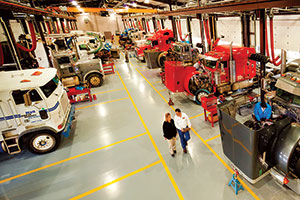Senior Reporter
Two Suppliers See 4Q Profits Fall, Plan Guarded Approach in 2016

Industry suppliers Rush Enterprises Inc. and Allison Transmission Holdings Inc. said net income and revenue dropped in the fourth quarter and that they were taking a guarded approach to 2016.
For the period ended Dec. 31, Rush, the nation’s only publicly traded commercial vehicle dealership, reported that quarterly net income of $9.8 million, or 24 cents, dropped 60% compared with $24.6 million, or 60 cents in the same quarter of the previous year.
Revenue slipped to $1.2 billion compared with $1.3 billion in the 2014 quarter.
For the year, net income fell 17% to $66.1 million, or $1.61 per share, compared with $80 million, or $1.96, in 2014.
Revenue rose to $5 billion from $4.7 billion reported in 2014.
The quarterly results included a $6.1 million write-down of new and used-truck inventory in the fourth quarter of 2015, which reduced quarterly and 2015 per-share earnings by 9 cents, according to the company.
“We were able to offset lost revenues from declining energy-related Class 8 truck sales with lower-margin truck sales to large fleets throughout 2015,” said W.M. “Rusty” Rush, chairman and CEO.
“This lower-margin business combined with declining demand for aftermarket services from the energy sector and a significant decline in used-truck values in the fourth quarter, had a negative impact on net income and earnings,” he said.
San Antonio-based Rush operates 118 dealerships in 21 states.
Overall, the company said it sold 37,702 new and used commercial vehicles in 2015, a 7% increase from 35,352 in 2014.
Of those, 16,874 were new heavy-duty trucks, 11,241 new medium-duty vehicles, 1,665 new light-duty vehicles and 7,922 used vehicles.
Looking at 2016, Rush said his company’s Class 8 sales could be off 15% to 20% compared with 2015. “A lot is going to have to do with the economy,” he said.
ACT Research forecast U.S. retail sales of Class 8 trucks to total 222,000 units in 2016, a 12.2% decrease from 2015 retail sales.
“Given the decreasing freight trends,” Rush said, “increased capacity as a result of 2015 being the best truck sales year since 2006, lower used-truck values and ongoing slowness in the energy sector, we believe 2016 U.S. retail sales of Class 8 trucks could be significantly less.”
Meanwhile, Allison Transmission, based in Indianapolis and a global provider of fully automatic transmissions for medium- and heavy-duty commercial vehicles, said that fourth-quarter net income of $13 million, or 8 cents, fell 74% from $50.5 million, or 28 cents, a year earlier amid weakness in its off-highway segment.
Revenue slipped to $478 million, down 12% from $544 million, but that exceeded the “consensus estimate of $465 million,” analyst Jamie Cook with Credit Suisse said in an investor note.
For the year, Allison reported net income of $182.3 million, or $1.03, down 20% from $228.6 million, or $1.25, in 2014.
Sales in 2015 slipped to $1.98 billion from $2.13 billion in 2014.
“During the fourth quarter, we refinanced all debt maturing in 2017 to 2019, settled $10 million of share repurchases, paid a dividend of 15 cents per share and repaid $6 million of debt,” according to the company’s earnings announcement.
Allison’s guidance is for its sales to fall 6.5% to 9.5% this year.
“Given expectations for tempering demand conditions in the North America on-highway end market, no meaningful relief from the global off-highway end markets challenges and divergent global economic environments, Allison is taking a guarded approach to 2016,” said Lawrence Dewey, chairman and CEO.
In a conference call, Dewey said the company has a “pretty clear view” of the next several months based on interactions with truck makers, relative to their line rates and down days.
“It appears they are addressing what has been a growing inventory situation, both in medium-duty and more pronounced in Class 8 straight trucks,” he said.
“Medium-duty is more stable, but still some signs of softness are there,” Dewey said.
“We look at the inventory-to-retail-sales numbers . . . and that has gone [in] the wrong direction,” he added, “and we have seen the [truck makers] addressing that in a fairly aggressive manner. Obviously, that impacts us.”




